In the previous articles I’ve touched on smaller spinners and even spinning rods, but they weren’t fully explained. So, in order to put this right, this article will do just that and I hope it will encourage you to have a go yourselves.
Rods for Autumn Spinning
All you need is a nice light, not too long rod, maybe 6½-8 feet is ideal, 9 feet at its longest. This is so that it won’t tire you out carting it around and continuously casting with it and you’ll be able to get it underneath overhanging trees. So many times, this is where perch like to hide out.
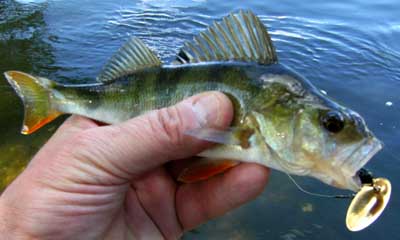
The rod should cast anything from a feather to around 14-21 grams (½-¾oz). Any heavier and you will find it doesn’t behave quite so well with the lightest of lures. You should always use a wire trace anyway to allow for the odd small pike grabbing your lure and the weight of the trace will add to the spinner’s casting weight.
I set a limit on mine (read Part 4) of 8 feet for a spinning rod and I do have one 8 foot rod casting from nothing to 15 grams in that bracket. But the better two I have are a 6’6” Daiwa Triforce (an American rod) casting 3 grams to 21 grams and another Daiwa (British this time) 7 foot Samurai casting 3- 15 grams. These two are perfect for when I know I’m walking a long way up the banks of the Thames.
As I have already said in a previous article, the old fashioned British idea of a spinning rod was 10 feet and even longer at one time. Although these might be OK for salmon spinning in the mighty Scottish rivers they’re not very appropriate for river perch. Unfortunately, the attitude of producing long rods has still not left the rod maker’s psyche.
Amongst the other items you will need to carry will be a reasonable length landing net and handle. You don’t need to spend a fortune, just a basic fibre glass two piece handle and a simple 20-24” pan landing net will suffice, even for small jacks. Some, myself included, carry a folding trout net, which is fine for many fish, but not long enough for some of the higher banks I fish from. So take one that suits your chosen venue.
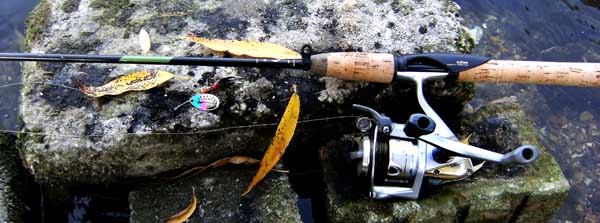
Reels
Just a normal open-faced spinning reel that you might use for float fishing will do the job. You can load it with monofilament nylon of 6-8lbs, but I am fully converted to braid these days and a good quality spinning braid, Power Pro, Sufix’s Performance or Matrix, Cortland’s Master Braid, of 15 – 20lbs should be ample. Go for quality and more importantly, a braid that is round and stays round as this prevents a lot of line twist.
The question will always arise, supposing you catch a big pike on a small rod with light braid. Isn’t that also always the question when you go float fishing in a lake for roach with 3 lbs line and hook a much larger carp? I’m afraid you have to deal with those situations as and when, and ‘IF’, they arise. Most time you can land fairly reasonable pike on this type of gear if you just take your time and don’t try bullying the fish.
You can use a reel like an Abu 505 or the latest 704, this is what I used for many years spinning for trout in the great northern reservoirs. I got along fine with them and they are brilliant when using the “catapult cast”. This is where you hold the treble hooks of the spinner (carefully) and bend the rod tip around so that when you release the spinner it flicks out catapult fashion.
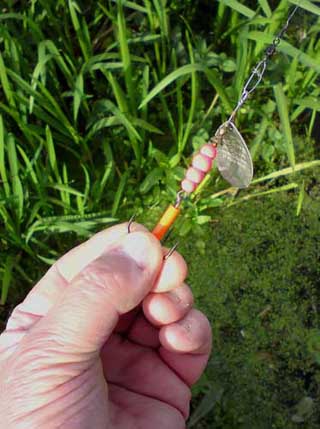
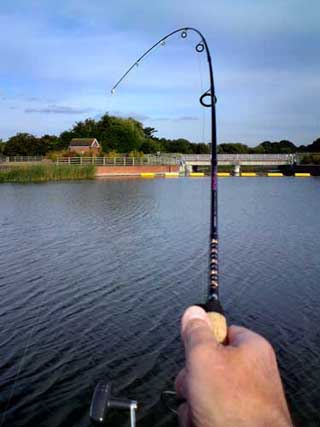
This does take some practice and you have to release the line from the reel at the perfect moment to gain the maximum distance for the cast. The spinner should hang from the rod to about two-thirds down the rod’s length. Don’t be afraid to fully depress the rod’s tip and many times, this is the only way to get the spinner out underneath over hanging branches. For accuracy of direction, hold the spinner beneath the reel and where the rod is pointing, that’s where the spinner should go. Try it.
Lastly, you can, if you really want, use a baitcasting rod and very light baitcasting reel for this job. However, if I take one along, it’s usually to cast tiny crankbaits for the perch, but then you’re just as likely to hook into small pike. So be careful.
The Best of the Spinners
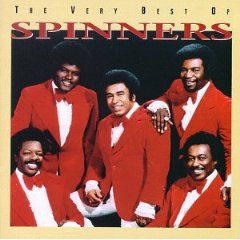
Not those Spinners! These spinners –
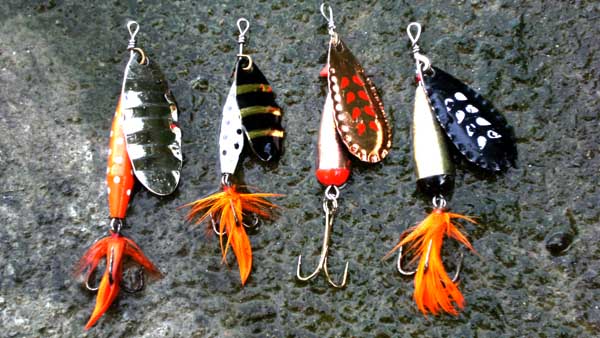
We have to start with the Abu. Mainly because they’re what I have come to swear by over the past forty and more years. Apart from one, the Flex which was soon to be discontinued, the first type I mainly bought were the Reflex (2 on left). These often have a dressed hook with hackles and originally had spotted bodies, many still have them, of course.Later, Abu introduced the Droppen (2 on right), which worked really well on the reservoirs. It cast nicely and the blade having a scalloped edge caused extra vibrations in the water, so Abu said. Anyway, I soon built up a reasonable collection of those as well as Abu’s Lill-Öringen, a neat little bar spoon that works very well for perch.
Next, you cannot possibly ignore Mepps. Quite a range as well with set sizes, 0, 1, 2, 3, 4, & 5 being the biggest and heaviest, more intended for pike. For small perch you should think of 1s, 2s, and 3s and you can get these with what they call a “dressed” treble hook. This means there’s a bunch of deer hair or feathers on the treble, all adding to the attractiveness.
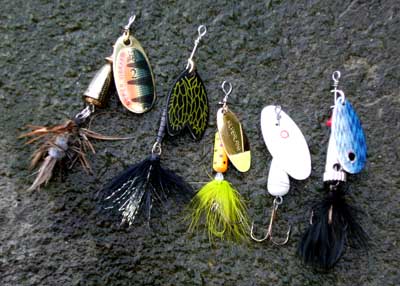
Similar in many ways to Mepps are Blue Fox lures (far left), the Vibrax name is used on their popular lures and again, these can come with dressed hooks. Then there are Rublex Ondex lures, often dressed with red wool on the hooks. Another popular lure from America is the Panther Martin, which has a rather unusual blade arrangement, but the Mepps Xd is the same if you can’t get hold of Panther Martins (the white one above).
In fact if you start to look on American sites, you will find many lures such as Wordens Rooster Tails, also with a dressed hook. Then you might even think about tiny spoons, the Abu Genial for example as well as the previously mentioned Lill-Öringen. What about some tiny spinnersbaits or even really small crankbaits such as tiny Salmos and Raiders.
Tactics
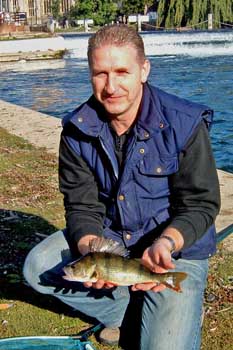 OK, so grab all of your gear. A small bag with some small lure boxes (I found some in Homebase much better than any others I’ve seen) and your collection of spinners and small spoons. Don’t forget a pair of forceps small enough to get into a perch’s mouth.
OK, so grab all of your gear. A small bag with some small lure boxes (I found some in Homebase much better than any others I’ve seen) and your collection of spinners and small spoons. Don’t forget a pair of forceps small enough to get into a perch’s mouth.
Set off up the bank of your river or canal (or maybe you have a lake well stocked with perch?) and stop at every promising swim you find. Cast your lures in a fan shape, first cast slightly upstream and work further down until your last cast is along the nearside bank. You might want another try with a different lure so start again in the same fan shape.
If you catch a fish make a mental note of where and what lure it was on. Try again in the same spot, perch are a shoal fish after all. Keep trying, but don’t spend too long in one spot, if after three cast to the same area you haven’t caught it’s time to move on.
Find the next swim and proceed with the tactic, maybe allow the lure to get down a little deeper this time. There aren’t any golden rules for any kind of fishing, but bear in mind an old saying; dark day, dull lure, bright day, bright lure. Vary it and go through all of your collection.
There have been times in the past I have covered maybe three miles of river and caught as many as 15 perch, the best was about 1½lbs. No monster, but it’s fun your after, not size and who knows, you might hook a surprise jack that’ll give you a good run for your money.
Try it this year.
PLEASE THOUGH – always use a lightweight WIRE trace, say 12-15lbs, as there is always a chance of a small jack taking it.
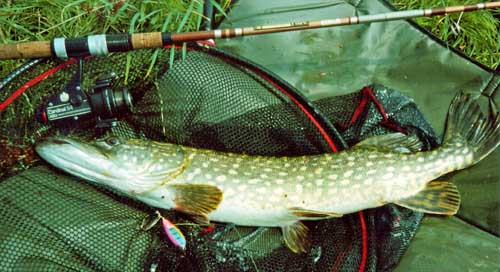
(And that, I promise you, is the very last in this series. Amen!)










